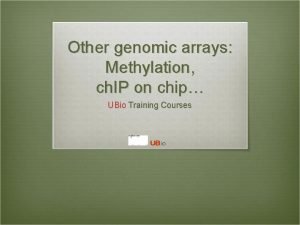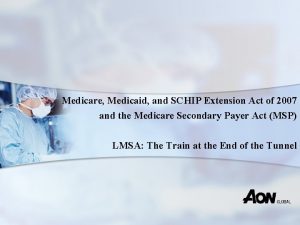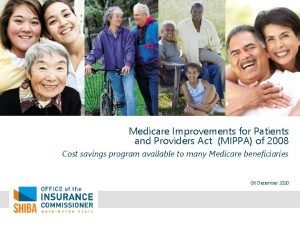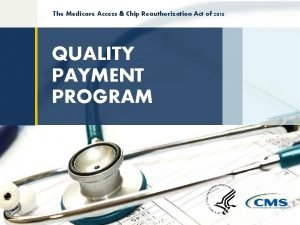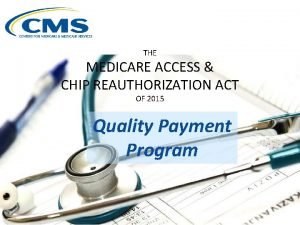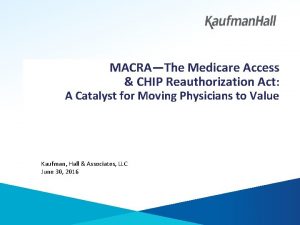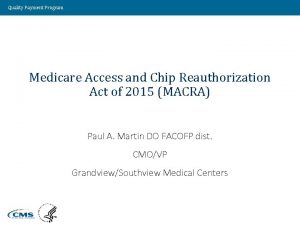The Medicare Access and CHIP Reauthorization Act of





- Slides: 5

The Medicare Access and CHIP Reauthorization Act of 2015 (MACRA) is a bipartisan legislation signed into law on April 16, 2015. Ø Repeals the flawed Sustainable Growth Rate (SGR) Formula Ø Creates a new reimbursement structure for healthcare providers by establishing two payment tracks, rewarding clinicians for value over volume and streamlines other existing quality reporting programs into one new system: v. Merit-Based Incentive Payments System (MIPS) v Alternative payment models (APMs)

The Merit-based Incentive Payment System (MIPS) consolidates three existing quality reporting programs, and create a plus adds a new program Ø Physician Quality Reporting System (PQRS) Ø Value-based Payment Modifier (VBPM) Ø Meaningful use (MU) Ø Clinical practice improvement activities (CPIA) Payment Schedule Ø Physicians participating in MIPS will be eligible for positive or negative Medicare payment adjustments. Information collected in 2017 will impact reimbursement in 2019. Ø Eligible professionals will receive a positive, negative, or neutral payment adjustment based on their composite score. The negative adjustment will be capped at four percent in 2019, five percent in 2020, seven percent in 2021 and nine percent in 2022.

Exemptions from MIPS include: Ø Providers in their first year billing Medicare; Ø Providers whose volume of Medicare payments or patients fall below the threshold (not yet defined); and Ø Providers who qualify for payment under APMs with the associated bonuses exempt from MIPS does not apply to hospitals or facilities

Ø What are APMs? – An innovative payment model expanded under the Center for Medicare & Medicaid Innovation (CMMI); – A Medicare Shared Savings Program (MSSP) accountable care organization (ACO); – Medicare Health Care Quality Demonstration Program or Medicare Acute Care Episode Demonstration Program; or – Another demonstration program required by federal law. Ø Unlike MIPS, APMs offer increased potential for risks and rewards Ø Eligible professionals will receive five percent bonuses each year from 2019 to 2024. Participation in an APM will also exclude eligible professionals from MIPS and most EHR Meaningful Use requirements. 4

Ø Requirements – Use of quality measures comparable to measures under MIPS; – Use of a certified electronic health record (EHR) technology; and – Assumes more than a “nominal financial risk” (which is undefined), OR is a medical home expanded under the CMMI. Ø A physician receiving the designated percentage of Medicare payments or patients through a qualified, eligible APM based on the above requirements is considered a “qualifying participant” (QP). Ø Qualifying APM Participant: – Are not subject to MIPS – 2019– 2024: Receive an annual 5% lump sum bonus payment – 2026–beyond: Receive higher fee schedule update 5

